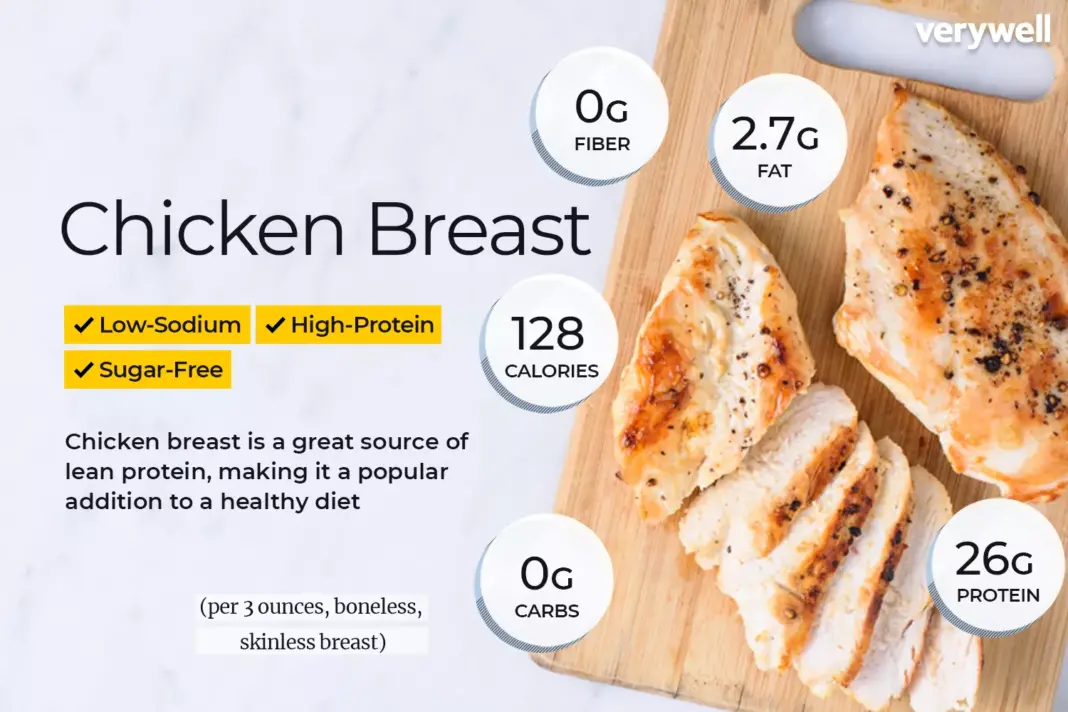Chicken breast is an excellent source of lean protein (protein without a lot of accompanying fat). That means most of the chicken breast calories and macronutrients (macros) come from protein. People who eat enough protein are more likely to maintain muscle mass and preserve a healthy metabolism Chicken Breast Nutrition Facts and Health Benefits.
In addition to being affordable and adaptable in the kitchen, chicken breasts can be prepared in a multitude of ways.For example, baked chicken breasts and air fryer chicken breasts tend to be convenient and healthy cooking methods. Learn more about food safety, the nutritional benefits of chicken breast, and how to prepare it as part of a balanced diet. Nutritional Information and Health Benefits of Chicken Breast.
Chicken Breast Nutrition Facts
The chicken breast macros for one 3-ounce (85g) grilled, boneless, skinless piece are 26 grams of protein and 2.7 grams of fat with zero grams of carbohydrates.1 This serving size also has 128 calories. Note that many commercially packaged chicken breasts are much larger than 3 ounces. So if you eat a single breast, you’re probably eating more than a single serving.Chicken Breast Nutrition Facts and Health Benefits
- Calories:128
- Protein:26g
- Fat:2.7g
- Carbohydrates:0g
- Sodium:44mg
- Fiber:0g
Calories
Protein makes up a full 80% of the calories in chicken breasts. Because chicken breast has no carbs, the remaining portion is made up of fat. There are 128 calories in a single 3- ounce serving of skinless chicken breast.Chicken Breast Nutrition Facts and Health Benefits
Protein
Lean protein is abundant in chicken breasts, with the majority of their macronutrients being protein. For people who eat meat, consuming chicken is a simple way to meet some of your body’s protein needs without consuming a lot of fat. Depending on the cooking method you choose, chicken breasts are also naturally low in sodium.Chicken Breast Nutrition Facts and Health Benefits
Fats
Skinless chicken breast contains a small amount of fat, fewer than 3 grams. It is mostly unsaturated fat (there is less than 1 gram of saturated fat in a 3-ounce portion of skinless chicken breast).
If you keep the skin on your chicken breast, the fat, calorie, and protein counts will all be higher. A 3-ounce (85g) serving of roasted, broiled, or baked chicken breast with skin on provides 166 calories, 6.6 grams fat, and 25 grams protein.
Cooking chicken breasts increases their fat content. For example, adding olive oil to a pan increases the amount of fat that is created in the final dish.Olive oil contains monounsaturated fat and polyunsaturated fat, both of which provide health benefits.Chicken Breast Nutrition Facts and Health Benefits
Carbs
Chicken breasts have no carbs because they don’t contain sugar or starch (unless they’re seasoned or breaded). Chicken breast has an estimated glycemic load of 0.
Vitamins and Minerals
Chicken breast is a very good source of the selenium, phosphorus, vitamin B6, and niacin. Selenium is important for thyroid function and making DNA.3 Niacin and B6 are both in the family of water-soluble B vitamins that play an essential role in cellular functioning.Chicken Breast Nutrition Facts and Health Benefits
Health Benefits
The low-fat protein in chicken breast can offer many significant advantages, making this food a helpful addition to many eating plans. Specifically, the nutrients in chicken breast can help with muscle mass, bone health, appetite control, and even mood and sleep.Chicken Breast Nutrition Facts and Health Benefits
Builds and Maintains Muscle Mass
Protein helps your body maintain muscle mass and also helps build muscle in conjunction with a strength training program.5 Because chicken breast is high in protein, it is part of a diet that can help you build muscle mass. Research shows that losses in muscle mass and strength are directly associated with mortality rates in older people. Consequently, it is critical to stop muscle loss at any age, especially if you aren’t making an effort to gain more muscle mass.
Strengthens Bones
Scientists and doctors once believed that a diet high in animal protein could reduce bone density and increase the risk of broken bones. However, more recent research shows that protein works with calcium to help protect bones.7 It’s crucial to consume enough protein to keep bones strong and healthy.Chicken Breast Nutrition Facts and Health Benefits
May Reduce Appetite
Consuming protein helps you feel full, which can help reduce food cravings and prevent overeating. One small study of overweight men on reduced-calorie diets, for example, found that those who ate more protein showed “improved appetite control and satiety. The amount of protein in chicken breast makes it a good choice for you if you’re hoping to boost your satisfaction with meals.Chicken Breast Nutrition Facts and Health Benefits
Boosts Serotonin and Melatonin
Chicken breast contains tryptophan, an essential amino acid that helps regulate protein synthesis. Tryptophan also contributes to your brain’s ability to synthesize serotonin. Individuals who don’t get enough serotonin may get depressive symptoms or memory problems.Moreover, tryptophan aids in the production of melatonin, a hormone essential for sleep.
Allergies
Poultry allergies are rare but are certainly possible. Doctors suggest that an allergy to poultry is about as common as an allergy to red meat (but being allergic to one kind of meat does not mean you will be allergic to other meats). Sometimes people with egg allergy have a secondary allergy to poultry. In this kind of allergy, reactions usually happen when coming into contact with raw meat and not consuming cooked meat.
Adverse Effects
When it comes to protein consumption, especially when it comes to high servings, people with kidney disease need to exercise caution. Consult a healthcare professional about the appropriate protein sources and dosages if you have kidney illness.
Since chicken breast contains an animal protein, it should not be consumed by anyone who follows a plant-based (vegetarian or vegan) diet.
Varieties
You can purchase chicken breasts that are pre-trimmed and ready to use. In many grocery stores and bulk warehouses, you might also find chicken breasts that are frozen and individually wrapped. If you buy one of these convenient options, be sure to check the nutrition facts label. These varieties of chicken breast may contain more sodium.
You may also see various labels on chicken marketing it as organic, antibiotic-free, etc. The U.S. Department of Agriculture (USDA) regulates these terms:
- Free range:“Producers must demonstrate to the Agency that the poultry has been allowed access to the outside.”
- Natural:“A product containing no artificial ingredient or added color and is only minimally processed. Minimal processing means that the product was processed in a manner that does not fundamentally alter the product. The label must include a statement explaining the meaning of the term natural (such as “no artificial ingredients; minimally processed”).”
- No hormones:“Hormones are not allowed in raising hogs or poultry. Therefore, the claim ‘no hormones added’ cannot be used on the labels of pork or poultry unless it is followed by a statement that says “Federal regulations prohibit the use of hormones.”
- No antibiotics:“The terms ‘no antibiotics added’ may be used on labels for meat or poultry products if sufficient documentation is provided by the producer to the Agency demonstrating that the animals were raised without antibiotics.”
- Organic:There are specific rules about how chickens must be raised and cared for in order to be labeled organic. For example, they must be given 100% organic feed.
Storage and Food Safety
Raw chicken can harbor bacteria, such as Campylobacter and Salmonella, that can cause illness. Cooking chicken to at least 165 degrees F will kill the bacteria, but safe handling of the raw meat during preparation is important. Never wash or rinse raw chicken, and always thoroughly clean hands, utensils, and surfaces after handling raw chicken.14
Both uncooked and cooked chicken should be kept in the refrigerator, where it will keep for a few days. Refrigerate or freeze leftover chicken within two hours of serving. You can freeze chicken for up to nine months, both raw and cooked.
How to Prepare
How you prepare chicken breast can significantly change your meal’s fat and calorie count. Roasting, broiling, poaching, and grilling are generally the healthiest preparation methods if you want to limit fat in your meal. Breading your chicken, frying or sautéing it in butter or oil, or adding condiments such as barbecue sauce will add fat and calories.
Chicken Breast Recipes
There are many delicious ways to enjoy chicken breasts with spices and sauces. Try one of these flavorful healthy recipes:
- Healthier Chicken Masala
- Chicken Caesar Salad with Homemade Creamy Caesar Dressing
- Low-Carb Creamy Southwest Chicken

